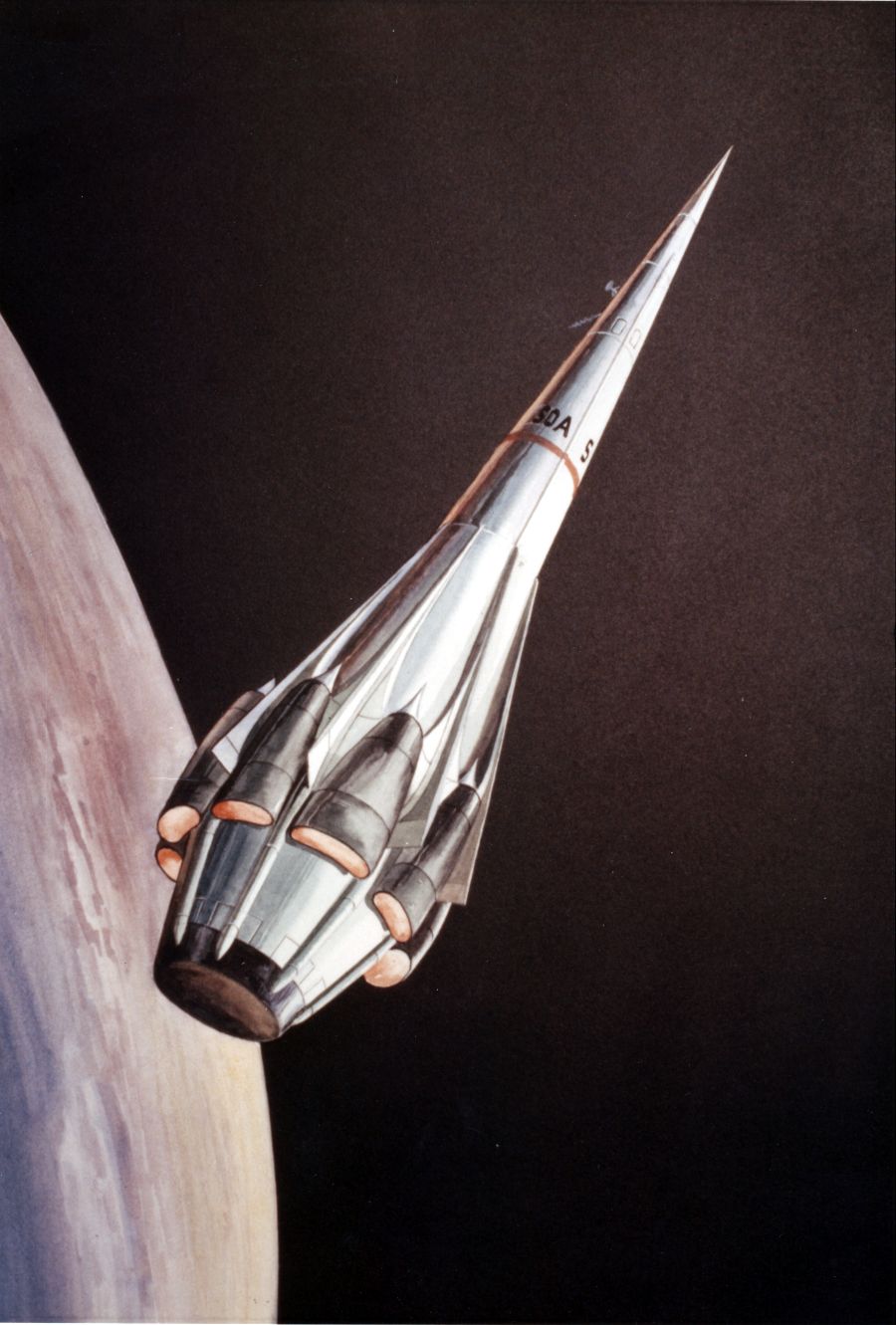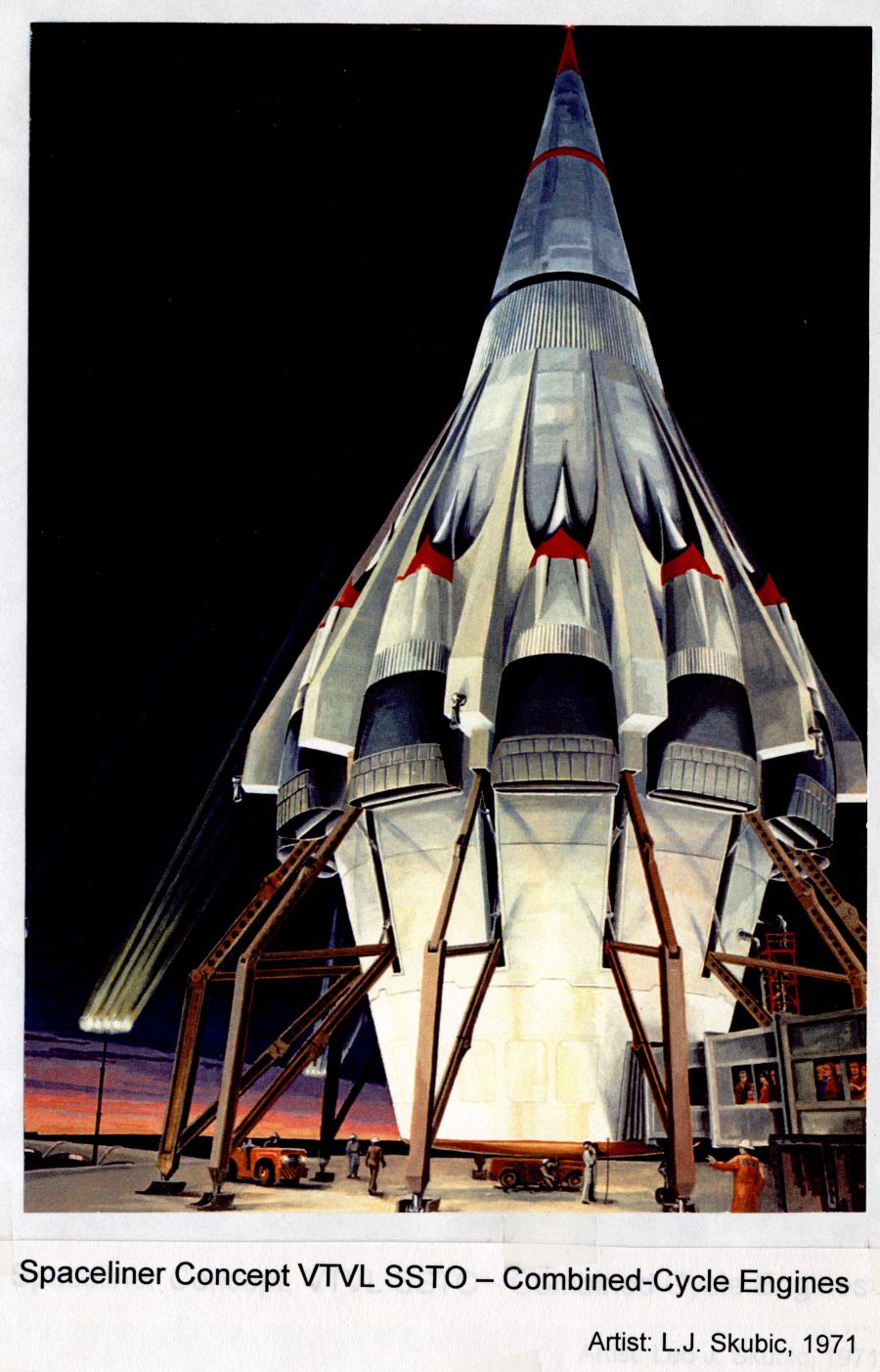May 182010
Artwork by Leo Skubic of Marquardt illustrating the “Spaceliner” SSTO concept. This used the Supercharged Recycled Scram LACE (“Synerjet”) concept for propulsion, and was intended as a Space Shuttle concept. The payload compartment was not in the nose, or in the middle, but instead was firmly in the rear of the vehicle… the central “plug” of the aerospike engine was the primarily payload compartment.
13 Responses to “Spaceliner, 1971”
Sorry, the comment form is closed at this time.


We going to see more of this as an APR article? 🙂
(And speaking of which I’ve got an “article” for this from the October 1986 Wisconsin Engineer magazine. Do you have that one, or should I send it to you?)
And I’d always wondered about the noise issues for the cabin during take-off and landing with this design. It actually makes sense, though.
Randy
I don’t know how well it would work, but it sure looks great, like something from the cover of a 1960’s sci-fi novel.
Now that’s a spaceship!
that’s sub zero cool Spaceship !
will be a eAPR article about the “Spaceliner” SSTO ?
Supercharged Recycled Scram LACE, is this simelar to HOTOL engine ?
Yeah, the thing looks like it has some sort of hyperspace drive modules wrapped around its waist.
Supercharged Ejector Ramjet/Scramjet cycle actually, according to what I’ve read on the vehicle. The entire vehicle is called the “Synerjet” with the “pods” around the waist of the vehicle being the individual ram/scramjet modules and a retractable “fan” in the forward section of each pod run off the expansion of the LH2 fuel via tip-turbine before being fed to the rocket motor(s). Couldn’t find a reference to the engine cycle having a “LACE” (Liquid Air Cycle Engine) anywhere??
Randy
> Couldn’t find a reference to the engine cycle having a “LACE” (Liquid Air Cycle Engine) anywhere??
“Synerjet: Beyond the Shuttle,” by Escher, Spaceflight magazine, date uncertain (the schmucks didn’t print dates or issue numbers on the pages).
“An attractive composite engine system on the basis of payload performance has already been identified in a study performed for NASA by Marquardt, Rocketdyne and the Lockheed-California company. This is the Supercharged Recycled Scram Lace engine referred to as ‘Synerjet Type 32’ since it was the 32nd of some 36 engines examined in the study. Although considerably more sophisticated than composite engines which are better known such as the SERJ (Supercharged Ejector Ramjet), Type 32 is representative of systems which might be appleid to a major downstream project like the advanced space transport discussed here.”
Thanks Scott, always happy to learn somthing new 🙂
Randy
Imagine, then, what new things you can learn from your very own Saturn V blueprint: http://up-ship.com/blog/blog/?p=6131
More to the point, imagine what you can learn from a *dozen* copies of your very own.
“Can I wallpaper my bedroom with these?”
“Will they make me irresistable to da wimmins?”
“Can I turn them around and sell then to my friends, family and co-workers for a substantial profit?”
Is it just me, or does anyone else think that this thing has around a 50% surplus in the landing gear department?
It looks like it has ten landing gears; five would be plenty.
Scott, this would make an interesting model, any other diagrams?
Title: Synerjet propulsion and the trimarket opportunity – Orbital, transglobal and lunar transportation services with one vehicle type
Author(s): Escher, William J. D.
Abstract: A proposed aerospace transporter for performing earth-to-orbit/return missions as well as transatmospheric and in-space high-energy missions is argued to be an effective and feasible alternative for development. The vehicles are based on the exploitation of ‘synerjet’ technologies that use airbreathing/rocket combined-cycle propulsion. The vehicle is shown to be capable of terrestrial-service intercontinental transglobal flight in an ‘orbital cruise’ mode as well as round trips from low orbits to high orbits and to the moon. The operational flexibility is linked to the development of synerjet propulsion, so directions are proposed for technology development and validation efforts. The development of the NASP X-30 by NASA is shown to be an important initial contribution to the R&D in this direction.
NASA Center: NASA (non Center Specific)
Publication Date: Jul 1, 1992
Document Source: Other Sources
No Digital Version Available: Go to Tips On Ordering
Document ID: 19920071509
Accession ID: 92A54133
Publication Information: Number of Pages = 14
Report Number: AIAA PAPER 92-3716
Keywords: RESEARCH AND DEVE
Very cool art, and a cool idea. NASA projected a combined cycle (rocket/ramjet/scramjet) would average twice the ISP to orbit of a pure rocket based system using the same fuel. This would certainly make SSTO easier.
Though I wonder about the safty and control issues of a VTVL config?
And yes Randy – wheres a copy of that article!
Thanks Mike for the AIAA article info.